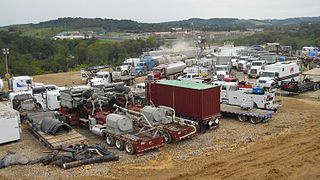From Guest Blogger Rebecca McKenzie: Is There Really a 100-year Supply of Shale Gas?

Indeed, in its Energy Plan for America, Dow Chemical maps out society’s transition to a low-carbon economy based on 100 years of natural gas providing its feedstocks and powering its plants. During this time Dow plans to develop renewable feedstocks as well as renewable energy sources that have sufficient base load.
Michael T. Klare has seen fit to describe this continued commitment to fossil fuels as a third carbon era. He explains:
When it comes to energy and economics in the climate-change era, nothing is what it seems. Most of us believe (or want to believe) that the second carbon era, the Age of Oil, will soon be superseded by the Age of Renewables, just as oil had long since superseded the Age of Coal. … There is only one fly in the ointment: it is not, in fact, the path we are presently headed down. The energy industry is not investing in any significant way in renewables. Instead, it is pouring its historic profits into new fossil-fuel projects, mainly involving the exploitation of what are called “unconventional” oil and gas reserves. … The result is indisputable: humanity is not entering a period that will be dominated by renewables. Instead, it is pioneering the third great carbon era, the Age of Unconventional Oil and Gas. (1)
But the claim that there is enough natural gas to keep us going for 100 years has been called into question. Richard Heinberg at the Post Carbon Institute says fracking’s “production potential was over-sold.” He continues:
America’s hundred years of natural gas, heralded by President Obama as a national energy game-changer, actually amounts to a mere 24 years by official estimates, even less according to unofficial but well-informed calculations. … Before 2020, shale gas and tight oil production will top out and start to decline. Americans will wonder what happened to the lavish economic benefits the industry promised. (2)
In a report published by the Post Carbon Institute called “Drill, Baby, Drill – Can Unconventional Fuels Usher in a New Era of Energy Abundance?” author J. David Hughes explains why the 100-year estimate is not accurate:
The metric most commonly cited to suggest a new age of fossil fuels is the estimate of in situ unconventional resources and the purported fraction that can be recovered. These estimates are then divided by current consumption rates to produce many decades or centuries of future consumption. In fact, two other metrics are critically important in determining the viability of an energy resource:
The rate of energy supply—that is, the rate at which the resource can be produced. A large in situ resource does society little good if it cannot be produced consistently and in large enough quantities…
The net energy yield of the resource, which is the difference between the energy input required to produce the resource and the energy contained in the final product. (3)
He discusses shale gas as follows:
Shale gas production has grown explosively to account for nearly 40 percent of U.S. natural gas production; nevertheless production has been on a plateau since December 2011—80 percent of shale gas production comes from five plays, several of which are in decline. The very high decline rates of shale gas wells require continuous inputs of capital—estimated at $42 billion per year to drill more than 7,000 wells—in order to maintain production. In comparison, the value of shale gas produced in 2012 was just $32.5 billion.
Thus the world faces not so much a resource problem as a rate of supply problem, along with the problem of the collateral environmental impacts of maintaining sufficient rates of supply. (4)
Environmental concerns around fracking are becoming better known – contaminated water, nosebleeds, headaches, dying pets and intolerable noise — despite industry’s claims that it can be done safely. (5)
Given these hazards, coupled with the effects of climate change through the continued use of hydrocarbons, it is hard to imagine us lasting even 50 years, let alone 100. The Department of Energy’s 2013 International Energy Outlook (IEO) predicts that global carbon emissions from energy will increase by a stunning 46% between 2010 and 2040, 27 years from now. (6) So even if there were enough shale gas to last the next century, it is unlikely that anyone would be around to use it.
The news that we may only have a 20-year supply of natural gas, and not 100, should spur us on to develop renewables even faster. And yet the continued use of fossil fuels is exactly what the Department of Energy foresees for decades to come, as the IEO reports. However, as Klare points out, although the major fossil fuel producers will not go down without a fight…
As the severity and destructiveness of climate change becomes increasingly evident in our lives, ever more people will be pressing governments around the world to undertake radical changes in global energy behavior and rein in the power of the giant energy companies. This, in turn, will lead to a substantially greater emphasis on investment in the development of alternative energy systems plus significantly less reliance on fossil fuels than the IEO anticipates. (7)
It appears, as usual, that it is only when a crisis is obvious to most people that meaningful change happens. We have managed (so far) to oppose war in Syria. We need the same kind of collective determination to make the Age of Unconventional Oil and Gas as short as possible.
Notes
1) http://www.commondreams.org/view/2013/08/08-2
2) http://www.commondreams.org/view/2013/08/23-0
3) http://www.postcarbon.org/reports/DBD-Exec-Summary.pdf
4) http://www.postcarbon.org/reports/DBD-Exec-Summary.pdf
5) http://www.commondreams.org/view/2013/08/23-0
